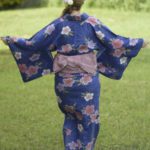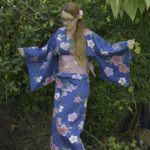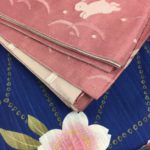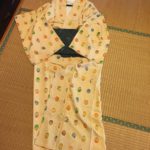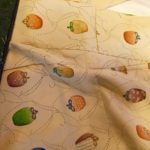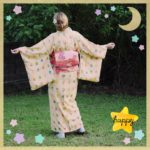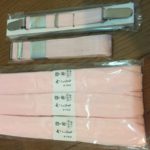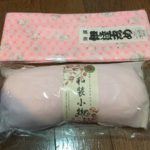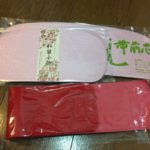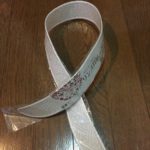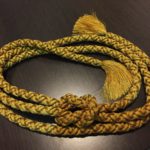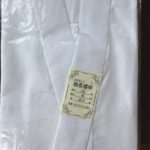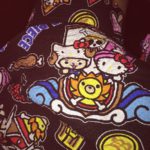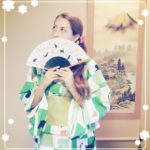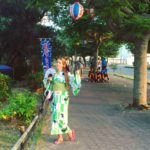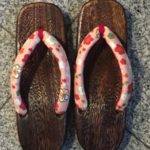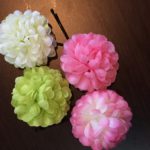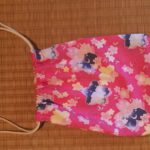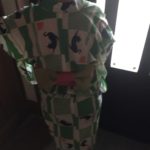I wrote about summer yukata in another post, but recently, I went to a used/bargain kimono and yukata sale… which of course led me to pick out some items for very cheap. While there were some beautiful pieces (even pre-picked out sets) for higher prices, my budget for these types of things is not very high. That being said, I am happy with my purchases.
First, I found a pink rabbit hanhaba obi (with a silvery pattern on the opposite side)… super kawaii. So since it is a casual (half) obi, I decided to look for a yukata that would match it; I ended up with a discounted medium blue yukata with pink and purple sakura-looking flowers on it. While normally I would not choose a flower pattern, this one contrasts and complements the obi so well. I am excited for next festival season already! I will need to alternate between my cats yukata and my bunny/flower yukata set.
The second combination I found was an antique komon 小紋 kimono 着物, which is a semi-formal/informal kimono with a repeating pattern (less rules, more free patterns and variety), and an full-width obi that I thought went well with it. The kimono is yellow-gold with a pattern of colorful omamori (charms, amulet) お守り; it is rather unique, and maybe a little kitschy, and definitely not your typically flowers or elegance. At first I though the design was pots, like for shoyu or sake (which sounds like an awesome design itself!) until I looked closer. The obi is a dark green with wisps of white and black color on it, so it gives a nice contrast to the bright colors on the kimono. It is not proper for full formal events, but rather better as a more casual piece, while still being acceptable for semi-formal events by dressing it up a bit. This is perfect since I cannot imagine any formal kimono events in my future! I have started to assemble the fiddly bits that I need to be able to wear the full kimono ensemble; just learning to tie this type of obi seems daunting in itself. I am even tempted to hire a kimono dresser at some point so I can get it put together properly! Yukata are quite simple, but kimono add layers upon layers of complication.
Some of the fiddly bits necessary for kimono dressing:
Being a bargain shopper meant going through a large number of fabrics and obi to find the right size (I am a medium height Western female, which means rather on the tall side compared to most Japanese females), quality (some had obvious defects hence the discount), price, and designs. After a good hour of perusing, I settled on these 2 sets after contemplating some other designs. Considering new kimono run to the equivalent of hundreds (or even thousands) of US dollars, paying 2000yen (~$20 USD) for an antique kimono in good condition made me happy. The other pieces were all cheaper (900yen each, except the bunny obi costing me 2200yen, the only item over budget).
In Okinawa, there are a few places you can find secondhand yukata and kimono, mainly “recycle” shops (リサイクル), such as Manga Souko and OFF-house (2 of the bigger chain recycle shops and well known to gaijin, though perhaps you could get lucky with a smaller unknown recycle shop). There are also a few secondhand and antique kimono specialty shops (such as Kimonobana, the shop that held the bargain event). Prices at recycle shops can be as low as 500-1000 yen, but often the quality will be very poor in this price range (unless you are very lucky!). Most prices seem to be a bit higher than this, and I have seen some very beautiful 30,000 yen (or more!) kimono in some of the secondhand shops, you can imagine what the orginal price must have been. Of the 2 larger chains, OFF-house seems to be a better value and selection than Manga Souko in my opinion. I have yet to explore all the secondhand kimono shops, but hopefully I can get around to it before the New Year. Overall, these are still a pretty decent deal compared to paying for new kimono, so if you are in Okinawa and interested in kimono and yukata options, definitely check out some of these places. And of course, keep your eyes out for used Kimono sale events that happen throughout the year.
